Source: communitycarbontrees.org
Published: April 6, 2017
Association Community Carbon Trees are community-based nonprofit reforestation projects. We sprout over 100 diverse tropical rainforest trees in two rainforest nurseries. Saplings are carefully transported and planted on degraded farmland owned by local farmers. Each site is strategically designed as a natural forest matrix, replicating the flow of nature. ACCT work crews including local women maintain the young rainforest trees for four years. This includes at least three supervised visits per year for maintenance and cleaning. Trees become well established to ensure a long, fruitful life and maximum carbon sequestration. Costa Rican farmers and families then take care of the trees for the next 21 years to grow a mature and bountiful forest, receiving instruction from ACCT. Learn more about our reforestation project management.
Plant a tree with ACCT!

Diverse Native Trees
We plant over 100 native species of diverse tropical rainforest trees. Our tropical trees range from fruit trees, to hardwoods, rare species, flowering trees, and medicinal trees. At least 50 different species are planted in each location, ensuring a diverse polycultural food and medicinal forest. Conventional monoculture forestry does not compare to our biodiverse polycultural farming.
Native trees are chosen for their unique adaptations to the local environment. They are less susceptible to stress, disease, and pests. Local people and local wildlife are familiar with these tropical trees and their many uses.
When We Plant Trees
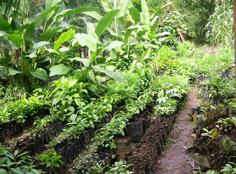
Tree planting season begins in early June, about one month into the rainy season. The soil is saturated and trees are happy to go into the ground! We vigorously plant until the end of August or September, leaving a few months of more rain before the dry season. This ensures trees have adequate time to establish deep root systems before facing four months of hot sun and dryness.
How We Plant Trees
Each reforestation project is a 25 year cycle. Young trees are maintained by ACCT work crews for the first four years. Once trees have grown above the surrounding vegetation, they are turned over to the participating farming family with ongoing maintenance support by ACCT. The family receives instruction for the next 21 years until the forest reaches maturity and robust carbon sequestration. This process of collaboration ensures strong growth rates and accountability for trees while providing food and income for families. Our strategically designed forests also provide food and homes for animals, protect rivers and water sources, control erosion, amend soils with nutrients, produce medicine, and rare hardwood and softwood lumber.
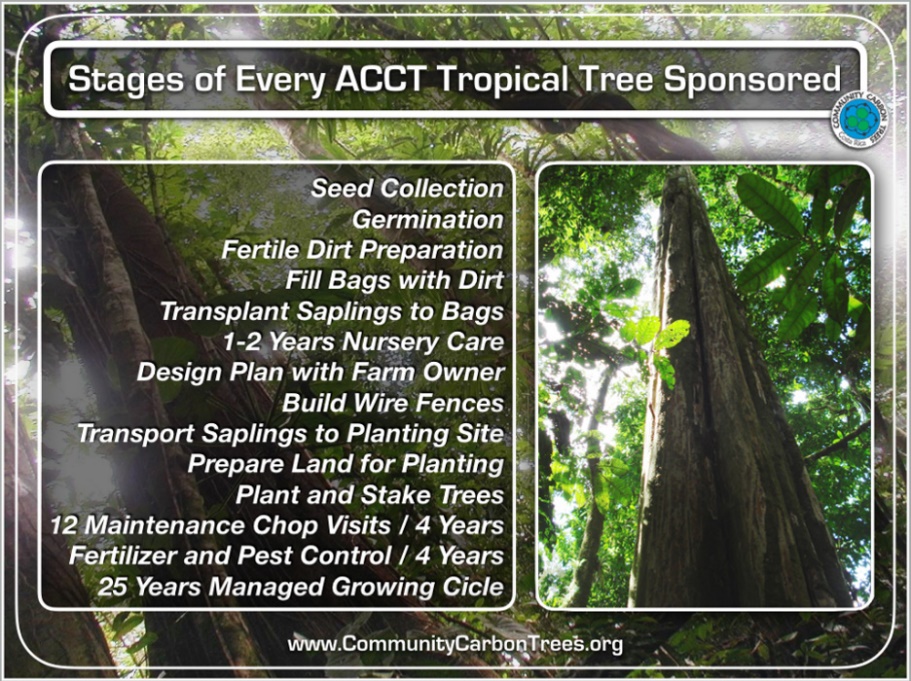
Seed Collection, Germination
Seeds and saplings are collected year round. Trees go to seed every week of the year. It is always time to collect seeds. Seeds are collected from existing reforestation projects and local intact rainforest segments. Seeds are germinated in the nursery and transplanted to small bags to grow. Sometimes seeds have already begun to sprout, thus small sprouts are collected from around existing trees and transplanted in the nursery. With instruction from trained employees, volunteers enjoy the ongoing collecting of seeds or baby trees and sprouting the seeds in the nursery (pictured below).

Land preparation
Land preparation and forest design are uniquely determined on a case-by-case basis. Factors such as grade of land, quality of soil, and existing vegetation determine what species to plant and where to plant.
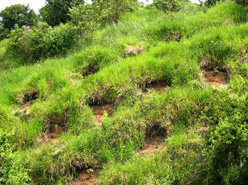
Local work crews use machetes to cut away low lying vegetation on steep terrains. Wide pathways, or “carriles” in Spanish, are cut into the contours of the land. Sometimes round circles, or “ruedas”, are cut with trees planted in the center. This is necessary to protect the young trees from sharp brush and vines, however, most vegetation is left untouched to maintain moisture and provide protection from the sun during the long dry season.
Most importantly, planting trees by hand with well paid and trained local labor provides great employment for families and preserves cultural ways of life. Delicate work by supervised workers causes minimal damage to soil and surrounding vegetation.
Transportation, Planting, and Staking
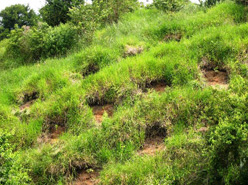
Trees are transported by truck then hand carried onto the site, being planted approximately five to eight meters apart. Transportation often requires jungle trekking, mountain climbing, river crossing, and more. Staking and maintenance ensures the best growth rates. Trees are supported with stakes to grow straight and strong. Thinning surrounding vegetation protects trees from competing plants and dehydration from the sun.
8-12 Maintenance Chop Visits
Grasses and surrounding vegetation are chopped for the first two to three years, requiring two to three maintenance visits per year. Chopping occurs during the rainy season when plant growth is strongest and foregone during the dry season to provide moisture and shade. Saplings are protected until they grow above surrounding vegetation.

25 Years of Sustainable Forest Management
After three to four years, trees have grown above the surrounding vegetation and have established strong root systems. Maintenance decreases to the occasional cleaning to remove vines, and open sunlight to ensure strong and straight, tall trees. Vigilance for pests and disease is constant. Companion food crops are always planted alongside trees to enrich the soil and provide sustenance for farmers. Farmers are given instruction and guidance for the next 21 years with ongoing maintenance support generated by robust carbon markets.
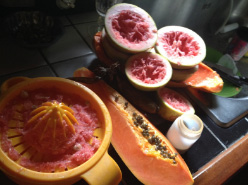
Sustainable forest management grows a food forest with endless resources such as fruits, medicines, and lumber. Local workers are employed. Farmers are given an alternative to the debt cycle of cattle farming, creating sustainable income for the family. A vibrant ecosystem is grown to prevent loss of biodiversity. One ton of carbon sequestration and storage is achieved per tree.
The latest statistics show that rainforest land converted to cattle operations yields the landowner $60 per acre and if timber is harvested, the land is worth $400 per acre. However, if these renewable and sustainable resources (nuts, fruits, medicines and essential oils) are harvested, the land will yield the land owner $2,400 per acre.
If managed properly, the rainforest can provide the world’s need for these natural resources on a perpetual basis. Promoting the use of these sustainable and renewable sources does stop the destruction of the rainforests. By creating a new source of income harvesting the medicinal plants, fruits and nuts, oil and other sustainable resources, the rainforests are more valuable alive than cut and burned to grow more and more monocultures and cows.

Sufficient demand of sustainable and ecologically harvested rainforest products is necessary for preservation efforts to succeed. Purchasing sustainable rainforest products can effect positive change by creating a market for these products while supporting the native people’s economy. This provides the economic solution and alternative to cutting the forest just for the value of its timber.
All of this happens and more when you choose to Plant a Tree!
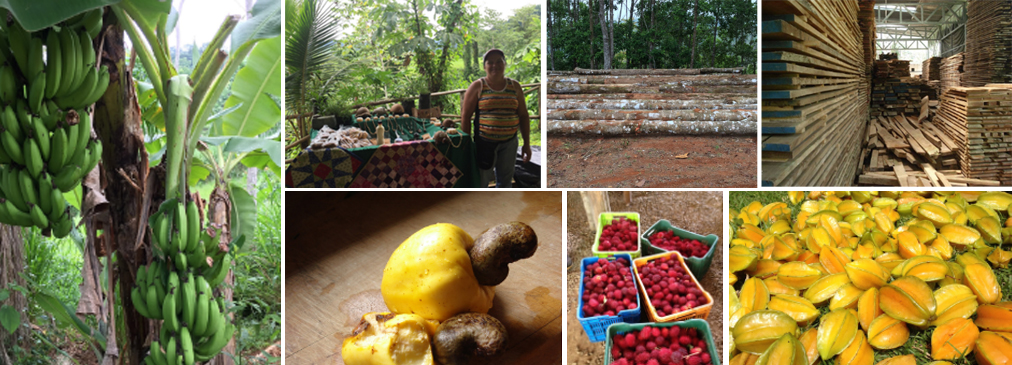
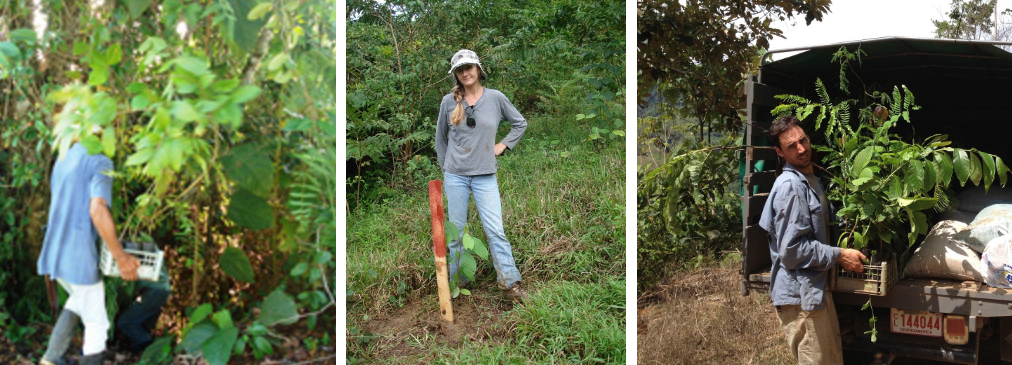
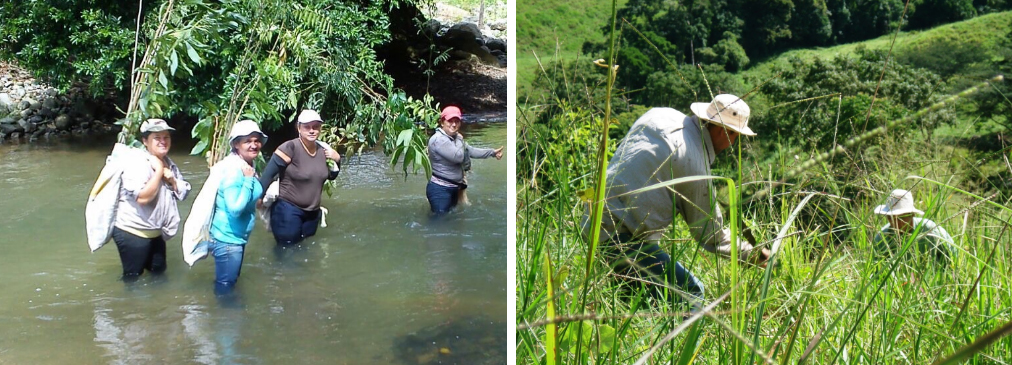
Where We Plant Trees
We plant trees in the San Juan de Dios valley. The San Juan de Dios valley has seen significant deforestation with increases of cattle farming in recent decades. With a regional need of fair paid labor, we began to form a dedicated network of women and men tree planters, maintenance workers, and nursery caretakers.
In 2016 we expanded to the region of San Jose de Rivas near Chirripo National Park. Jessica and Eduardo are the people on the ground dedicated to protecting community water and providing sustainable reforestation jobs. Current employment consists of coffee farming and fair paid local jobs are needed. A total of 1050 trees of 40 species will be planted this year.
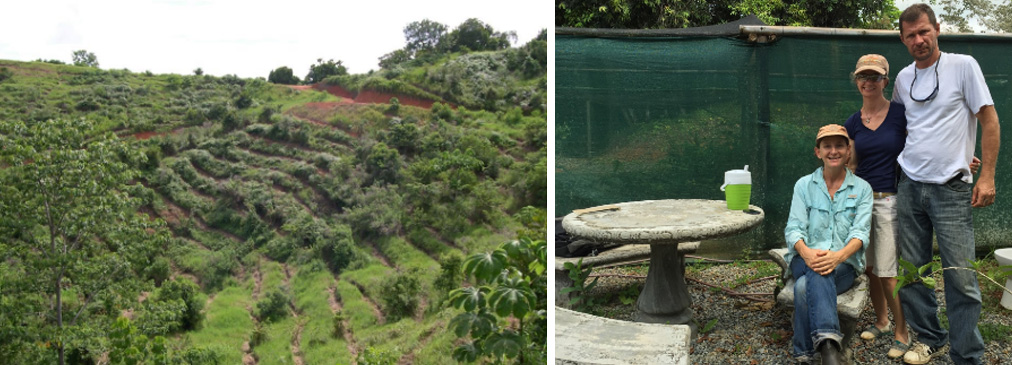
Risks To Trees
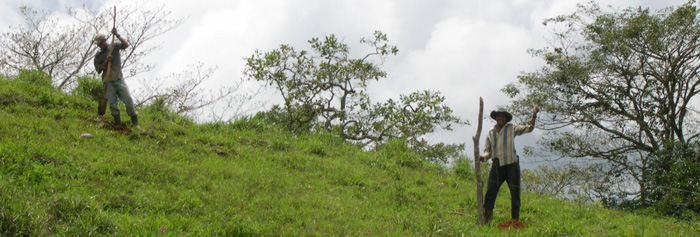
Species Selection
Tree species selection is key to success. Resilient, native trees that provide sustainable resources are staple to our forests. Species of trees are chosen for their unique resistance to pests and disease. A selection of strong species is the start of our record for low mortality loss.
Soil

Soil analysis is done prior to planting. Preparing special soils and amending degraded soil adds nutrients for best results. This is done by our specially trained women’s group and nursery workers. Planting nitrogen fixing leguminous trees and plants that enrich the soil naturally is another best practice.
Fungus
Nursery trees are susceptible to fungal attack due to the moist and humid climate of Costa Rica. Nursery sites are uniquely chosen for high sun, well-drained areas with solarized soils. Young saplings are treated with a proven effective antifungal agent to prevent fungus growth. Once a taproot has matured, the risk of fungal infection drops dramatically.
Insects
Pests and insects such as aphids, scales, and ants are mitigated with proven effective local practices. Trees are closely watched for infectious breakouts. When an infection occurs natural, non-toxic remedies are used to protect the plant. A tree may be removed to prevent the spread of an infection. Hunter bugs such as praying mantises and spiders are promoted for a simple natural solution.
Ants can become a major problem if not dealt with properly. Using the excrements from an ant’s nest can create a protective barrier. Non-phyto-toxic fungus killer can be added to a colony’s food supply to starve it to death. Ants are very common in Costa Rica and can strip a tree in a matter of days.
Animals
Large animals may uproot saplings to eat tender roots. This has occurred in the past with wild pigs and escaped cows. Sturdy wire fences are installed around tree planting areas to create a protective barrier from large, hungry animals. After several months of rooting, a tree’s chances of survival greatly increases. Fences are maintained by crews and farming families throughout the 25 year cycle.
Fires
Forest fires rarely happen in the humid tropical climate, particularly on the central to southern Pacific coast during the rainy season. Sometimes local Ticos slash and burn grassy hillsides on deforested farms. These fires are generally controlled. ACCT work crews and advisors work with locals to design and promote alternative practices to destructive slashing and burning.
Hurricanes and Severe Storms
Historically, hurricanes are not a problem in Costa Rica. They rarely hit the Caribbean side of the country. We are located on the Pacific side, which is separated by a 3350 meter (11,000 foot) mountain range. This range acts as a massive buffer and shelter from such storms.
More recently, Costa Rica has been affected by an increase of severe weather, both flooding and drought, due to climate change. This presses upon the need to plant more trees to protect hillsides, riverbanks, roads, farms, and more. In 2009 the Hurricane Alma was the first hurricane to ever form off the pacific coast of Costa Rica. See our section on climate change for more information.
Tree Guarantee
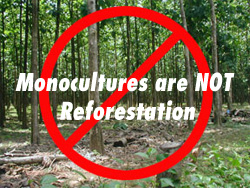
Our reforestation project model, created from over 17 years of experience, using best practices for tree growth and understory management results. Even more, if a tree dies, it will be replaced! You are guaranteed a full-grown tropical rainforest tree every time you donate a tree.
Dead trees are replaced during maintenance visits by ACCT work crews. If a tree is going to die, it will usually happen during the first two years after planting. We check for mortality through the first two years. Sometimes farm soils or water runoff can be adjusted to help trees in zones of higher mortality loss. We always plant it forward and plant more trees on each farm than we count. We love trees and our mortality losses reveal good management with between 3% to 6% mortality loss.
Community Tree Nurseries
Our community works hard all year long to collect all kinds of seeds from the existing rainforest and prepare them for germination in our tree nurseries. It is a constant job to grow rainforest trees from seed and often daily care is required especially during the summer months. Rainforest seeds are recalcitrant or hard to germinate and require a wealth of knowledge and experience for success. Our community has over 17 years experience identifying and collecting seeds and germinating them in our tree nurseries. Boasting production and cultivation for approximately 8 months to three years, Community Carbon Tree produces more than 110 species of rainforest trees and shrubs and medicinal plants. We produce all kinds of fruit for animals and humans as well as an exotic selection of rare native hardwoods. Over 14 trees threatened with extinction can be found in our nurseries as well as a selection of bamboos and vetivers for erosion control.
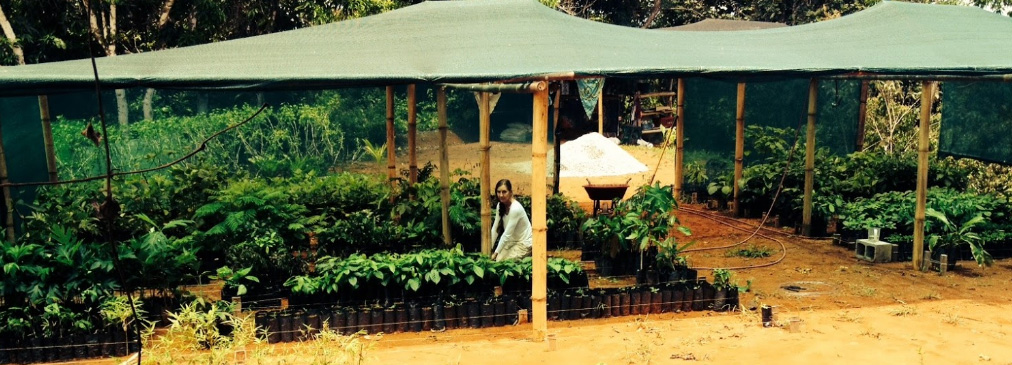
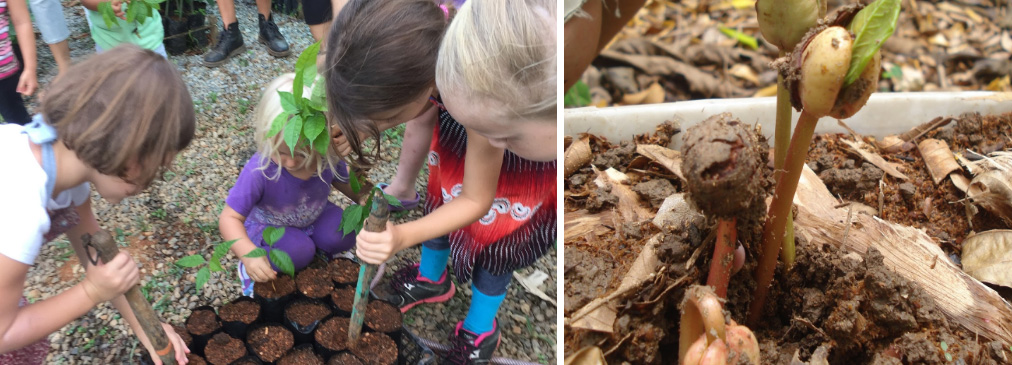

Getting the local residents and tourists involved in seed collecting and production of rainforest trees brings awareness for the necessity of conserving the existing rainforests still standing in the southern zone of Costa Rica. Other communities around the world consult with Community Carbon Trees for our example of collecting local seeds and producing baby trees with the help of many hands.
Notably, women from the local community assist in the process of helping to produce the baby trees by producing fertile compost soil using materials from their own farms and collecting excess cow poop from along nearby rivers. Read about our Women’s group here. This avoids further nitrogen fixing into rivers and watersheds.
Why rainforests and oceans are important.

Community Carbon Trees hosts regular Kids Nature Day events in our Tree Nurseries for tourists and communities who want to participate and get their hands in the dirt to actively help save the rainforest and absorb carbon dioxide by planting tropical trees.
